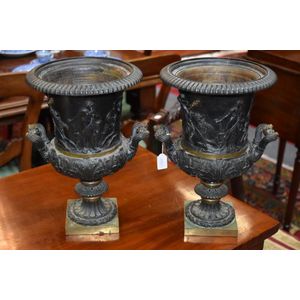Regency Bronze Campana Urns with Classical Scene Decoration
Pair of 19th century Regency bronze campana twin handled urns decorated with classical scene, height 29 cm
You must be a subscriber, and be logged in to view price and dealer details.
Subscribe Now to view actual auction price for this item
When you subscribe, you have the option of setting the currency in which to display prices to $Au, $US, $NZ or Stg.
This item has been sold, and the description, image and price are for reference purposes only.
- Bronze - An alloy of copper and tin, traditionally in the proportions of about 9 parts of copper to 1 part of tin.
The discovery of bronze in Western Asia in the 4th century enabled people to create metal objects which were superior to those previoulsy possible because of its strength and hardness, and it has been used throughout the world for weapons, coins, tools, statuary and other decorative items.
It is very fluid in a molten state, and its hardness, strength when set, and non-corrosive properties makes it most suitable for casting sculpture. - Regency Period - The Regency period in English furniture design refers to the period when King George III, was declared unfit to rule in 1811, and his son ruled as proxy as Prince Regent, until 1820, and then, after the death of his father as George IV until his death in 1830. The Regency period was preceded by the Georgian period (George I, George II, and George III: 1714 - 1811), and was followed by the William IV period, which only lasted until 1837 when William IV died as was succeeded by Queen Victoria.
- Campana Form Vases or Urns - A campana form vase or urn is a type of ceramic or metal container that is characterized by its reverse bell-like shape. The shape is typically wider at the top and narrower at the bottom, with a curved or flared opening at the top. The vase or urn may have a handle or handles on either side of the opening.The campana form was popular in ancient Greece and Rome, and the design has been revived in various forms throughout the history of art, including the Renaissance and the Art Nouveau period.
This item has been included into following indexes:
Visually similar items

A Santa Cruz Missionary staff, with mother-of-pearl inlay on all four sides, an inlaid cross at finial, 85 cm long
Sold by
in
for
You can display prices in $Au, $US, $NZ or Stg.

Antique bayonet, marks to handle and casing
Sold by
in
for
You can display prices in $Au, $US, $NZ or Stg.

A French bronze figure of Fulconis on a marble base circa 1900, with original receipt, 28 cm
Sold by
in
for
You can display prices in $Au, $US, $NZ or Stg.

A particularly fine and ornate gilded overmantel mirror
Sold by
in
for
You can display prices in $Au, $US, $NZ or Stg.
